A Multifunctional Battery-Free Bluetooth Low Energy Wireless Sensor Node Remotely Powered by Electromagnetic Wireless Power Transfer in Far-Field
Abstract
:1. Introduction
2. Targeted Application: Structural Health Monitoring
- -
- The need for reliable and robust wireless communication that enables the signal to be received from and through the materials, regardless of their composition (e.g., reinforcements) and state (e.g., wet, or dry);
- -
- The need for energy autonomy despite the physical inaccessibility of the sensing nodes (e.g., for replacing their batteries)
- -
- The choice of a secure, long-range and trusted wireless communication between sensing nodes and of a data management strategy controlling how data are spread.
2.1. Lifetime Issues: Wireless Power Transfer
2.2. Wireless Communication: Bluetooth Low Energy
2.2.1. Characteristics of the Bluetooth Low Energy
2.2.2. BLE System-on-Chip (SoC)
3. Architecture of and Design of the Proposed Wireless Sensing Node
3.1. Design of the RF-To-DC Conversion Circuit: The Rectifier
3.2. Sensing Subsystem
3.2.1. Bluetooth Low Energy Transceiver QN9080
Algorithm and Configuration
Evaluation of the Power Consumption
- (1)
- Without any available or sufficient power, the SN stays permanently in power-off mode without any activity of the hardware.
- (2)
- The functioning of the SN starts with an inrush current followed by register initialization and calibration of the sensors. This stage represents a large part of the consumption during the broadcasting phase. The SN has a high peak demand of 14.6 mA in the start-up process once powered by DC voltage.
- (3)
- A following adverting event after the initialization phase is produced to avoid restarting the MCU, and thus a supplementary consumption as seen in the next three advertising events. The advertising interval is set to 250 ms and a timer of 1 s is implemented to send four advertisements. Each advertising event starts with a wake-up of the MCU and transmission of packets on the dedicated channel (37, 38, 39). A detailed view of advertising packets is shown in Figure 6.
- (4)
- After each advertising event, the SN goes into sleep mode with low current consumption. The average current measured is 27 µA.
- (5)
- The last current consumption phase is produced by the function to stop advertisement after the timer of 1 s. An additional function is programmed for the resistivity measurement by canceling the measured current across the probes.
3.2.2. The BQ22570 Power Management Unit
3.2.3. The AEM30940 Power Management Unit
4. Implementation and Experimental Results
4.1. Comparison of the Power Management Unit
4.2. Radiated Performance Evaluation
5. Conclusions
Author Contributions
Funding
Acknowledgments
Conflicts of Interest
References
- Morais, R.; Mendes, J.; Silva, R.; Silva, N.; Sousa, J.J.; Peres, E. A Versatile, Low-Power and Low-Cost IoT Device for Field Data Gathering in Precision Agriculture Practices. Agriculture 2021, 11, 619. [Google Scholar] [CrossRef]
- Kubler, S.; Derigent, W.; Thomas, A.; Rondeau, E. Problem Definition Methodology for the “Communicating Material” Paradigm. IFAC Proc. Vol. 2010, 43, 198–203. [Google Scholar] [CrossRef] [Green Version]
- Jover, J.; Thomas, A.; Leban, J.-M.; Canet, D. Interest of New Communicating Material Paradigm: An Attempt in Wood Industry. In Proceedings of the the 4th France-Russia Conference on New Achievements Materials and En- vironmental Sciences (NAMES), Nancy, France, 26–29 October 2010; p. 012031. [Google Scholar]
- Jo, B.-W.; Park, J.-H.; Yoon, K.-W. The Experimental Study on Concrete Permeability of Wireless Communication Module Embedded in Reinforced Concrete Structures. Int. J. Distrib. Sens. Netw. 2013, 9, 520507. [Google Scholar] [CrossRef] [Green Version]
- Liu, Y.; Deng, F.; He, Y.; Li, B.; Liang, Z.; Zhou, S. Novel Concrete Temperature Monitoring Method Based on an Embedded Passive RFID Sensor Tag. Sensors 2017, 17, 1463. [Google Scholar] [CrossRef] [Green Version]
- Mekki, K.; Derigent, W.; Zouinkhi, A.; Rondeau, E.; Thomas, A.; Abdelkrim, M.N. New Communicating Concrete for Data Storage and Retrieval through Integrated Micro Sensor Nodes. In Proceedings of the 2016 IEEE 4th International Conference on Future Internet of Things and Cloud (FiCloud), Vienna, Austria, 22–24 August 2016; pp. 178–185. [Google Scholar]
- Loubet, G.; Takacs, A.; Dragomirescu, D. Towards the Design of Wireless Communicating Reinforced Concrete. IEEE Access 2018, 6, 75002–75014. [Google Scholar] [CrossRef]
- Loubet, G.; Takacs, A.; Gardner, E.; De Luca, A.; Udrea, F.; Dragomirescu, D. LoRaWAN Battery-Free Wireless Sensors Network Designed for Structural Health Monitoring in the Construction Domain. Sensors 2019, 19, 1510. [Google Scholar] [CrossRef] [Green Version]
- Barroca, N.; Borges, L.M.; Velez, F.J.; Monteiro, F.; Górski, M.; Castro-Gomes, J. Wireless Sensor Networks for Temperature and Humidity Monitoring within Concrete Structures. Constr. Build. Mater. 2013, 40, 1156–1166. [Google Scholar] [CrossRef] [Green Version]
- Kim, S.; Vyas, R.; Bito, J.; Niotaki, K.; Collado, A.; Georgiadis, A.; Tentzeris, M.M. Ambient RF Energy-Harvesting Technologies for Self-Sustainable Standalone Wireless Sensor Platforms. Proc. IEEE 2014, 102, 1649–1666. [Google Scholar] [CrossRef]
- Bahk, J.-H.; Fang, H.; Yazawa, K.; Shakouri, A. Flexible Thermoelectric Materials and Device Optimization for Wearable Energy Harvesting. J. Mater. Chem. C 2015, 3, 10362–10374. [Google Scholar] [CrossRef]
- Hou, L.; Tan, S.; Zhang, Z.; Bergmann, N.W. Thermal Energy Harvesting WSNs Node for Temperature Monitoring in IIoT. IEEE Access 2018, 6, 35243–35249. [Google Scholar] [CrossRef]
- Enescu, D. Thermoelectric Energy Harvesting: Basic Principles and Applications. In Green Energy Advances; IntechOpen: London, UK, 2019; p. 1. [Google Scholar]
- Sezer, N.; Koç, M. A Comprehensive Review on the State-of-the-Art of Piezoelectric Energy Harvesting. Nano Energy 2021, 80, 105567. [Google Scholar] [CrossRef]
- Liu, Y.; Khanbareh, H.; Halim, M.A.; Feeney, A.; Zhang, X.; Heidari, H.; Ghannam, R. Piezoelectric Energy Harvesting for Self-Powered Wearable Upper Limb Applications. Nano Select 2021, 2, 1459–1479. [Google Scholar] [CrossRef]
- Roy, S.; Tiang, J.-J.; Roslee, M.B.; Ahmed, M.; Kouzani, A.Z.; Mahmud, M.A. Design of a Highly Efficient Wideband Multi-Frequency Ambient RF Energy Harvester. Sensors 2022, 22, 424. [Google Scholar] [CrossRef] [PubMed]
- Nguyen, M.T.; Nguyen, C.V.; Truong, L.H.; Le, A.M.; Quyen, T.V.; Masaracchia, A.; Teague, K.A. Electromagnetic Field Based Wpt Technologies for Uavs: A Comprehensive Survey. Electronics 2020, 9, 461. [Google Scholar] [CrossRef] [Green Version]
- Valenta, C.R.; Durgin, G.D. Harvesting Wireless Power: Survey of Energy-Harvester Conversion Efficiency in Far-Field, Wireless Power Transfer Systems. IEEE Microw. Mag. 2014, 15, 108–120. [Google Scholar]
- Wu, F.; Redouté, J.-M.; Yuce, M.R. We-Safe: A Self-Powered Wearable Iot Sensor Network for Safety Applications Based on Lora. IEEE Access 2018, 6, 40846–40853. [Google Scholar] [CrossRef]
- Ruan, T.; Chew, Z.J.; Zhu, M. Energy-Aware Approaches for Energy Harvesting Powered Wireless Sensor Nodes. IEEE Sens. J. 2017, 17, 2165–2173. [Google Scholar] [CrossRef]
- Raju, S.; Lei, Y.D.; Lih, L.W.; Shyang, L.B.; Hui, T.P.; Raja, M.K. A Self-Sustained Sensor Node through Far-Field Wireless Powering. In Proceedings of the 2019 IEEE Asia-Pacific Microwave Conference (APMC), Singapore, 10–13 December 2019; pp. 1604–1606. [Google Scholar]
- Huda, S.M.; Arafat, M.Y.; Moh, S. Wireless Power Transfer in Wirelessly Powered Sensor Networks: A Review of Recent Progress. Sensors 2022, 22, 2952. [Google Scholar] [CrossRef]
- La Rosa, R.; Costanza, M.; Livreri, P. Advanced Techniques for Powering Wireless Sensor Nodes through Energy Harvesting and Wireless Power Transfer. In Proceedings of the 2020 AEIT International Conference of Electrical and Electronic Technologies for Automotive (AEIT AUTOMOTIVE), Turin, Italy, 18–20 November 2020; pp. 1–6. [Google Scholar]
- La Rosa, R.; Livreri, P.; Trigona, C.; Di Donato, L.; Sorbello, G. Strategies and Techniques for Powering Wireless Sensor Nodes through Energy Harvesting and Wireless Power Transfer. Sensors 2019, 19, 2660. [Google Scholar] [CrossRef] [Green Version]
- Loubet, G. Autonomous Wireless Sensor Networks for the Implementation of Communicating Materials. Application to Civil Engineering Industry. Ph.D. Thesis, Institut National des Sciences Appliquées, NSA, Toulouse, France, 2021. [Google Scholar]
- Strangfeld, C.; Johann, S.; Müller, M.; Bartholmai, M. Embedded Passive RFID-Based Sensors for Moisture Monitoring in Concrete. In Proceedings of the 2017 IEEE Sensors, Glasgow, UK, 29 October–1 November 2017; pp. 1–3. [Google Scholar]
- González-López, G.; Romeu, J.; Cairó, I.; Segura, I.; Ikumi, T.; Jofre-Roca, L. Wireless Sensing of Concrete Setting Process. Sensors 2020, 20, 5965. [Google Scholar] [CrossRef]
- Landaluce, H.; Arjona, L.; Perallos, A.; Falcone, F.; Angulo, I.; Muralter, F. A Review of IoT Sensing Applications and Challenges Using RFID and Wireless Sensor Networks. Sensors 2020, 20, 2495. [Google Scholar] [CrossRef] [PubMed]
- Bluetooth Technology Overview. Available online: https://www.bluetooth.com/learn-about-bluetooth/tech-overview/ (accessed on 6 December 2021).
- QN908x: Ultra-Low-Power Bluetooth Low Energy System on Chip (SoC) Solution|NXP Semiconductors. Available online: https://www.nxp.com/products/wireless/bluetooth-low-energy/qn908x-ultra-low-power-bluetooth-low-energy-system-on-chip-solution:QN9080 (accessed on 6 December 2021).
- QN9090/30(T). Available online: https://www.nxp.com/products/wireless/bluetooth-low-energy/qn9090-30-bluetooth-low-energy-mcu-with-armcortex-m4-cpu-energy-efficiency-analog-and-digital-peripherals-and-nfc-tag-option:QN9090-30 (accessed on 20 April 2022).
- NRF52833–Nordic Semiconductor. Available online: https://www.nordicsemi.com/Products/nRF52833 (accessed on 20 April 2022).
- BlueNRG-LP–Programmable Bluetooth® LE 5.2 Wireless SoC–STMicroelectronics. Available online: https://www.st.com/en/wireless-connectivity/bluenrg-lp.html (accessed on 20 April 2022).
- Radio SoC, Bluetooth 5 Certified. Available online: https://www.onsemi.com/products/wireless-connectivity/wireless-rf-transceivers/rsl10 (accessed on 20 April 2022).
- EFR32BG22 Series 2 Bluetooth Low Energy (SoC)–Silicon Labs. Available online: https://www.silabs.com/wireless/bluetooth/efr32bg22-series-2-socs (accessed on 20 April 2022).
- SmartBond DA14530 and DA14531|Dialog. Available online: https://www.dialog-semiconductor.com/products/bluetooth-low-energy/da14530-and-da14531 (accessed on 20 April 2022).
- Du, Z.-X.; Zhang, X.Y. High-Efficiency Single-and Dual-Band Rectifiers Using a Complex Impedance Compression Network for Wireless Power Transfer. IEEE Trans. Ind. Electron. 2017, 65, 5012–5022. [Google Scholar] [CrossRef]
- Huang, M.; Lin, Y.L.; Ou, J.-H.; Zhang, X.; Lin, Q.W.; Che, W.; Xue, Q. Single-and Dual-Band RF Rectifiers with Extended Input Power Range Using Automatic Impedance Transforming. IEEE Trans. Microw. Theory Tech. 2019, 67, 1974–1984. [Google Scholar] [CrossRef]
- Soyata, T.; Copeland, L.; Heinzelman, W. RF Energy Harvesting for Embedded Systems: A Survey of Tradeoffs and Methodology. IEEE Circuits Syst. Mag. 2016, 16, 22–57. [Google Scholar] [CrossRef]
- Song, C.; Huang, Y.; Zhou, J.; Carter, P.; Yuan, S.; Xu, Q.; Fei, Z. Matching Network Elimination in Broadband Rectennas for High-Efficiency Wireless Power Transfer and Energy Harvesting. IEEE Trans. Ind. Electron. 2016, 64, 3950–3961. [Google Scholar] [CrossRef] [Green Version]
- Gu, X.; Hemour, S.; Guo, L.; Wu, K. Integrated Cooperative Ambient Power Harvester Collecting Ubiquitous Radio Frequency and Kinetic Energy. IEEE Trans. Microw. Theory Tech. 2018, 66, 4178–4190. [Google Scholar] [CrossRef]
- SMS7630-005LF Skyworks Solutions, Inc. Diode-Schottky|Skyworks. Available online: https://store.skyworksinc.com/products/detail/sms7630005lf-skyworks-solutions-inc/113182/ (accessed on 13 February 2022).
- Sidibe, A.; Takacs, A. Compact 3D Rectenna for Low-Power Wireless Transmission. In Proceedings of the 2021 XXXIVth General Assembly and Scientific Symposium of the International Union of Radio Science (URSI GASS), Rome, Italy, 28 August–4 September 2021; pp. 1–4. [Google Scholar]
- HDC2080 Datasheet|TI.Com. Available online: https://www.ti.com/document-viewer/HDC2080/datasheet/GUID-5AB554A1-5F5B-4CF8-B0D0-9590654E767A#TITLE-SNAS678SNAS6781218 (accessed on 6 December 2021).
- AN2731, Compact Planar Antennas for 2.4 GHz Communication. Available online: https://www.nxp.com/docs/en/application-note/AN2731.pdf (accessed on 17 May 2022).
- Ghamari, M.; Villeneuve, E.; Soltanpur, C.; Khangosstar, J.; Janko, B.; Sherratt, R.S.; Harwin, W. Detailed Examination of a Packet Collision Model for Bluetooth Low Energy Advertising Mode. IEEE Access 2018, 6, 46066–46073. [Google Scholar] [CrossRef]
- QN9080SIP Development Kit. Available online: https://www.nxp.com/design/development-boards/freedom-development-boards/wireless-connectivy/a-highly-extensible-platform-for-application-development-of-qn9080sip:QN9080SIP-DK (accessed on 14 February 2022).
- MCUXpresso Integrated Development Environment (IDE). Available online: https://www.nxp.com/design/software/development-software/mcuxpresso-software-and-tools-/mcuxpresso-integrated-development-environment-ide:MCUXpresso-IDE (accessed on 17 May 2022).
- QN9080DK: A Highly Extensible Platform for Application Development of QN908x|NXP Semiconductors. Available online: https://www.nxp.com/products/wireless/bluetooth-low-energy/a-highly-extensible-platform-for-application-development-of-qn908x:QN9080DK (accessed on 12 April 2022).
- WCAP-ASLI Aluminum Electrolytic Capacitors Datasheet. Available online: https://www.we-online.com/catalog/datasheet/865080143008.pdf (accessed on 17 May 2022).
- BQ25570 Datasheet|TI.Com. Available online: https://www.ti.com/document-viewer/BQ25570/datasheet/revision-history-slusbh21212#SLUSBH21212 (accessed on 6 December 2021).
- AEM20940 RF Energy Harvesting|Radio Frequency Harvesting. Available online: https://e-peas.com/product/aem30940/ (accessed on 13 February 2022).
- Sidibe, A.; Takacs, A.; Loubet, G.; Dragomirescu, D. Compact Antenna in 3D Configuration for Rectenna Wireless Power Transmission Applications. Sensors 2021, 21, 3193. [Google Scholar] [CrossRef]


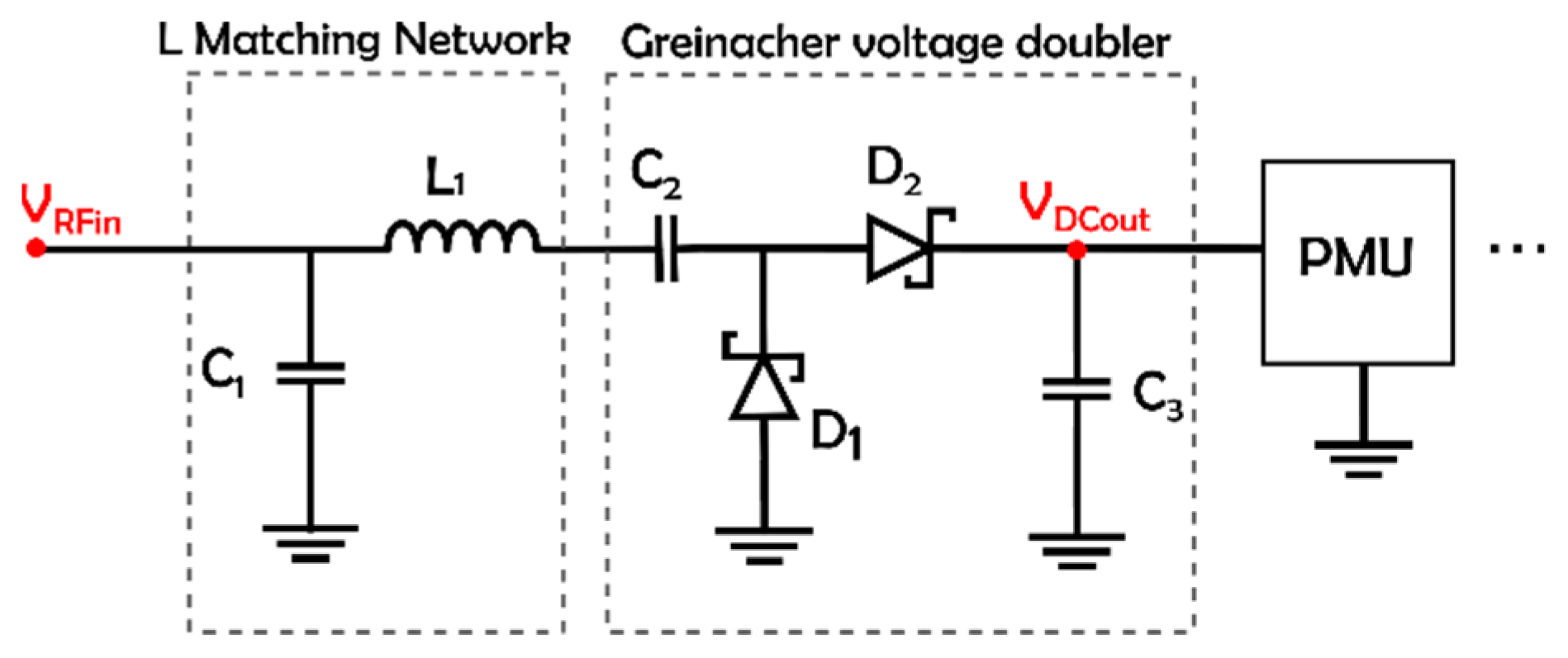

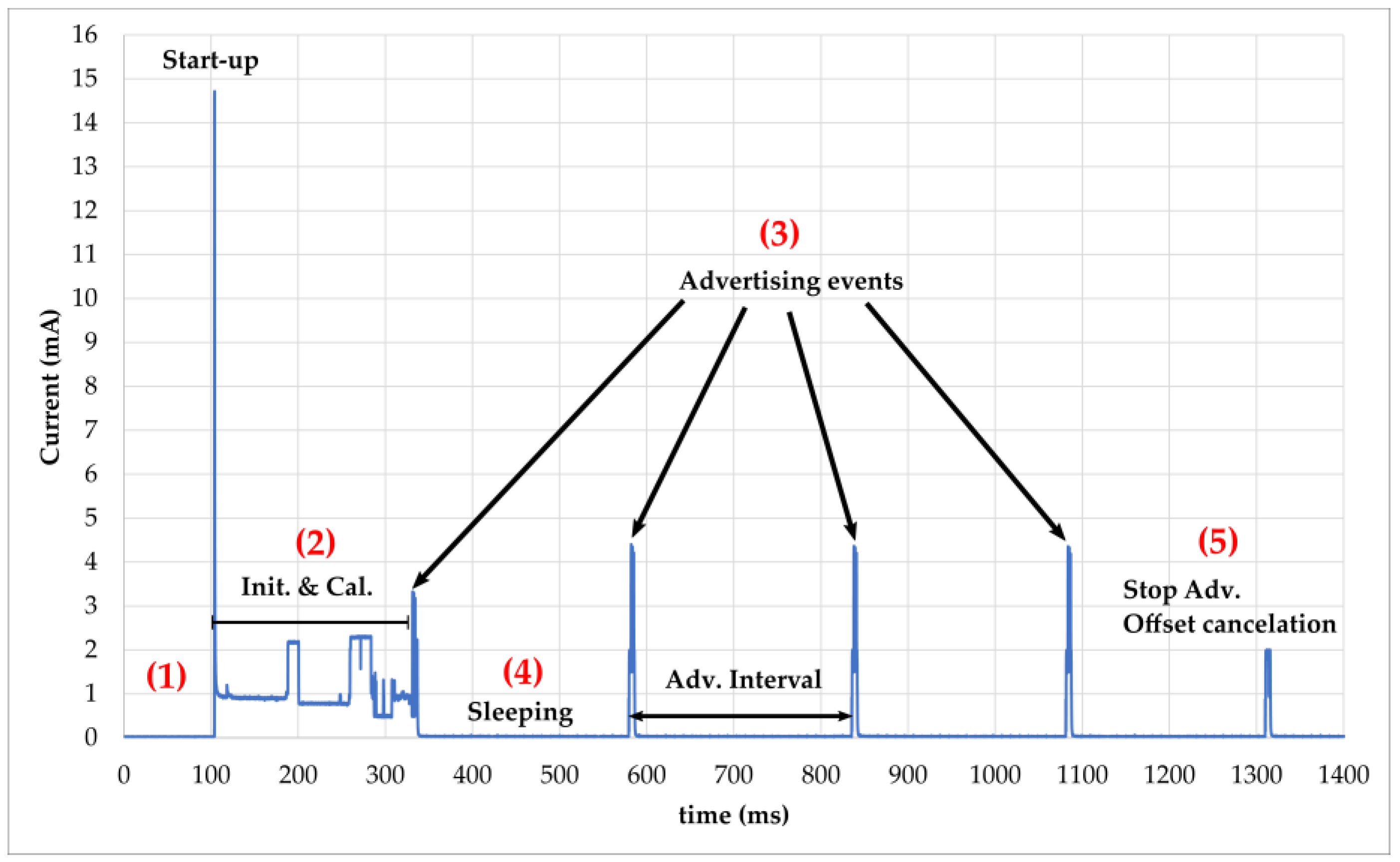
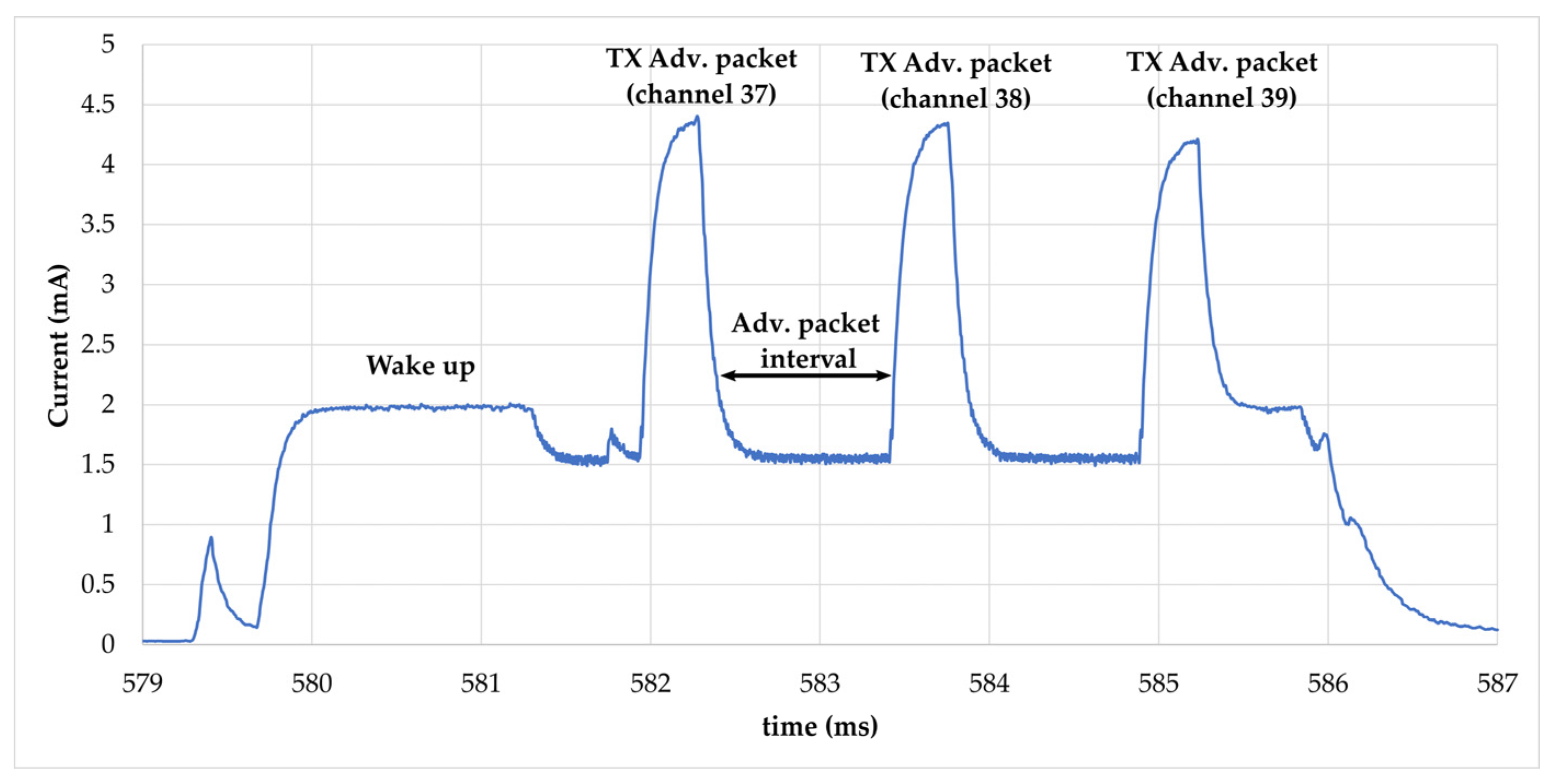


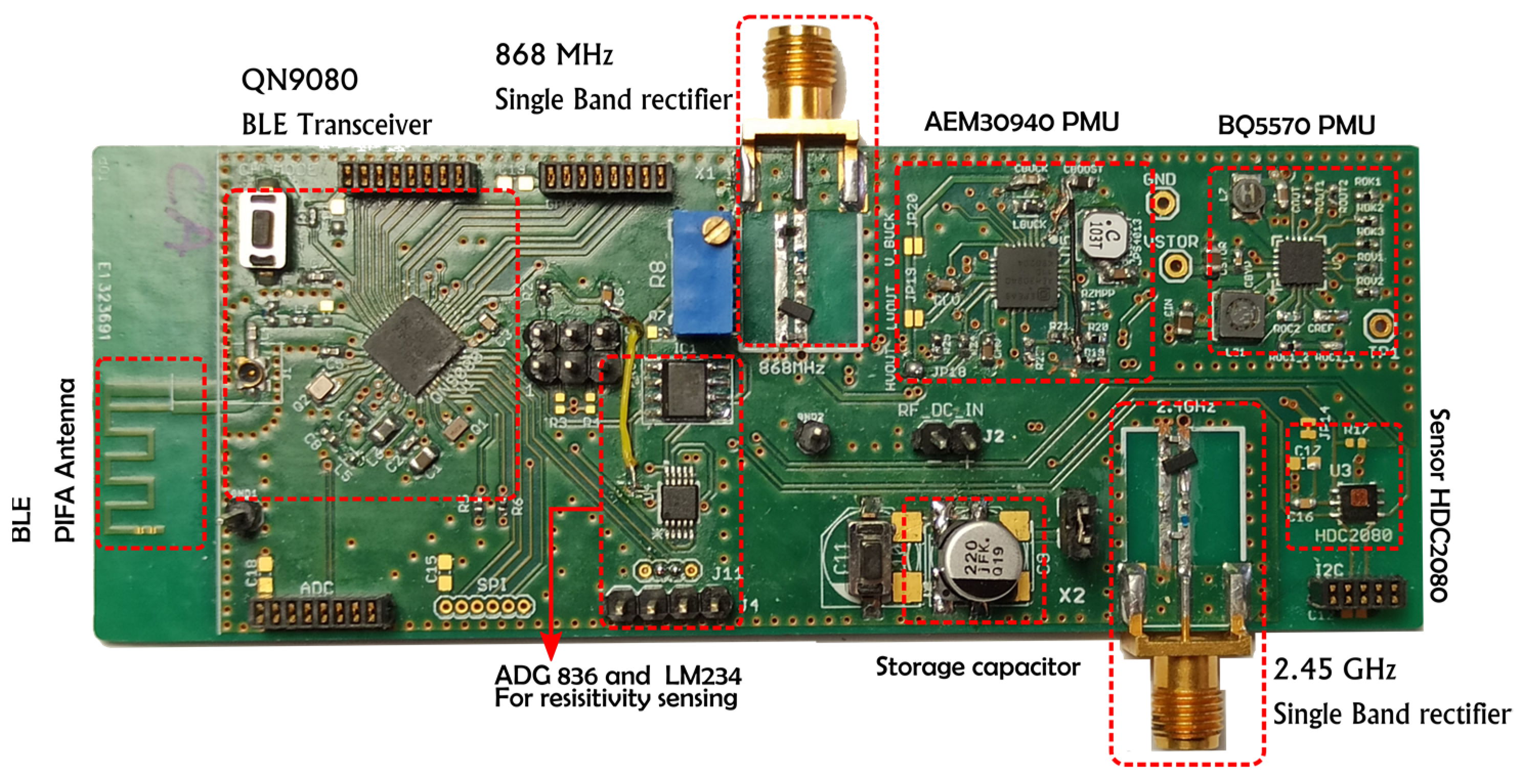
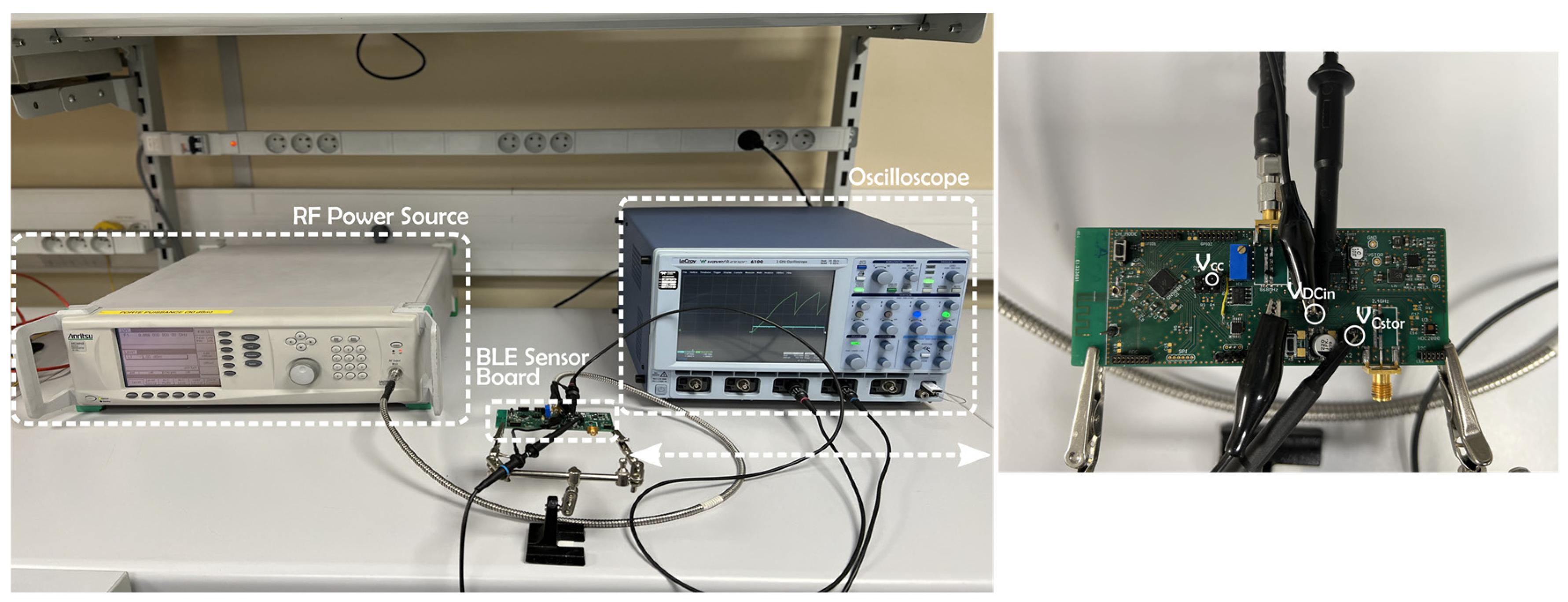

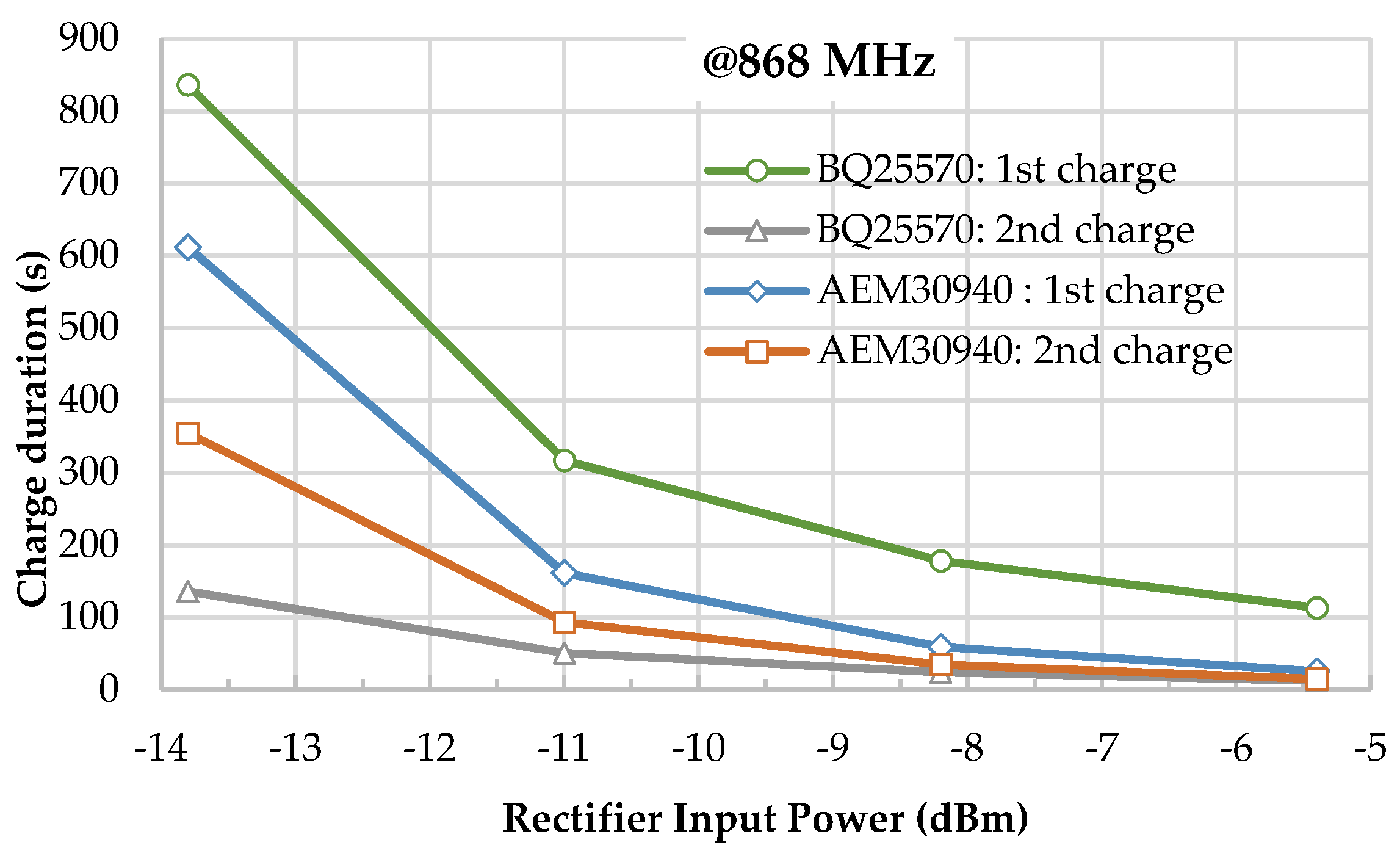


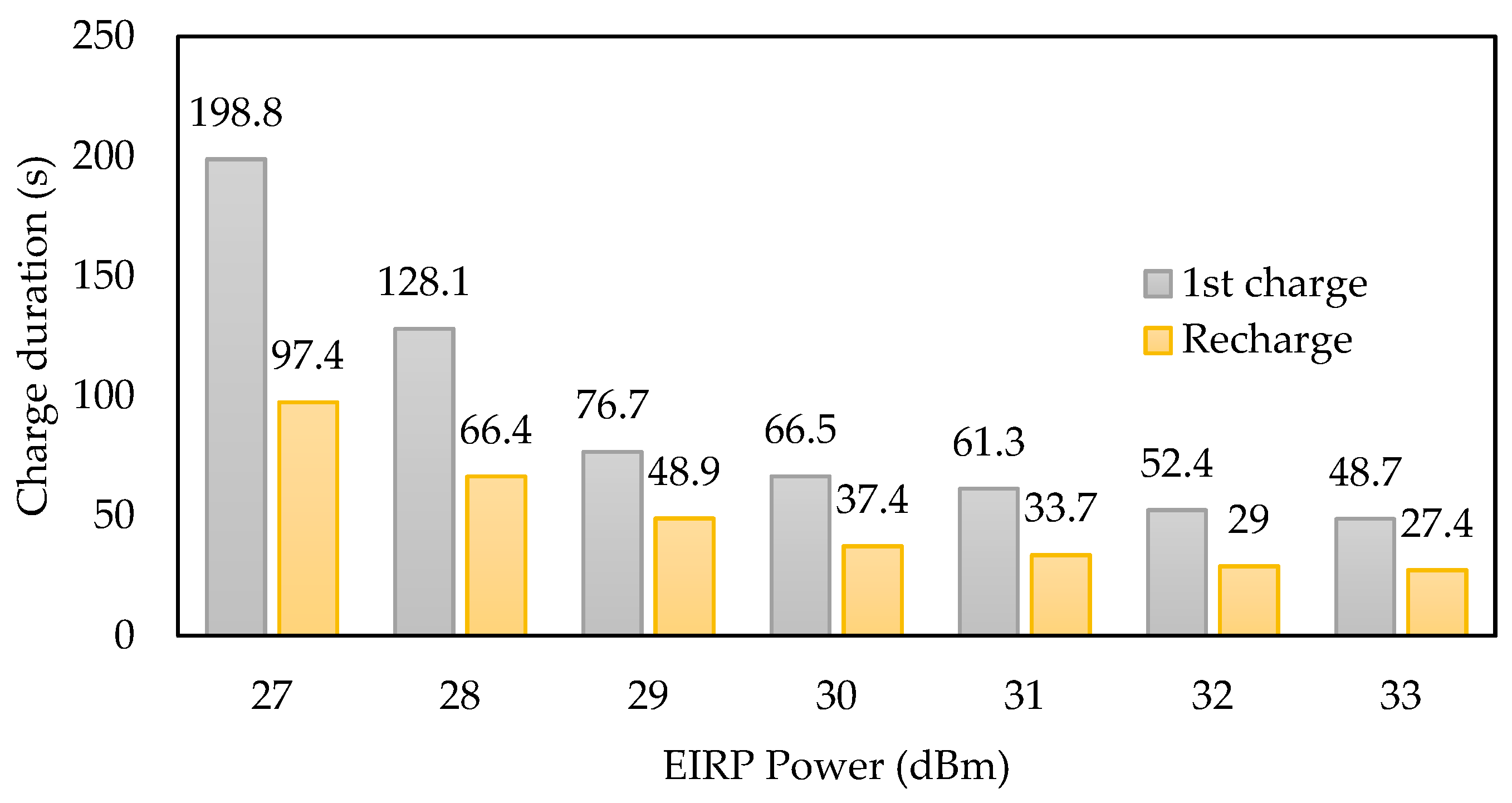
| Ref. | EH Sources | Power Density | Applications | Communicating Protocol | Size | Harvested Power |
|---|---|---|---|---|---|---|
| [19] | Solar: Indoor Outdoor | 600 lux n. a | Wearable safety (CO2, T° and H) | LoRaWAN | Round solar panel (radius of 30 mm) | 0.7 mW (@1.24 V) 90 mW (@1.8 V) |
| [20] | Piezoelectric | 600 με at 10 Hz | Aircraft (T°, H and Acc.) | ZigBee | 50 mm × 85 mm | 3.2 mW |
| [12] | Thermal | 110 °C with a heater | Industrial plants (T°) | ZigBee | 40 mm × 40 mm | 3.6 mW |
| [21] | RF | +26 dBm at 868 MHz | IoT | BLE | 60 mm × 40 mm | 48 µW (at 4 m) |
| Parameters | QN908x [30] | QN9090 [31] | nRF52833 [32] | BlueNRG-LP [33] | RSL10 [34] | EFR32BG22 [35] | DA14531 [36] |
|---|---|---|---|---|---|---|---|
| Sensitivity (dBm) 1 | −95 | −97 | −95 | −97 | −94 | −98.9 | −94 |
| Tx power (dBm) | −30 to +2 | Up to +11 | −20 to +8 | −20 to +8 | −17 to +6 | −27 to +6 | −19.5 to +2.5 |
| Rx current (mA) | 3.5 | 4.3 | 6.0 | 3.4 | 3.0 | 3.6 | 2.2 |
| Tx current (mA) 2 | 3.5 | 7.4 | 6.0 | 4.3 | 4.6 | 4.1 | 3.5 |
| Deep-sleep mode current (nA) | 1000 | 350 | 1300 | 900 | 100 | 1050 | 1200 |
| Supply voltage (V) | 1.62 to 3.6 | 1.9 to 3.6 | 1.7 to 5.5 | 1.7 to 3.6 | 1.1 to 3.3 | 1.71 to 3.8 | 1.1 to 3.3 |
| ADC | 16-bit 8-channel | 12-bit 8-channel | 12-bit | 12-bit 8-channel | 8 to 14-bit | 12-bit | 10-bit |
| Frequency | L1 | C1 |
|---|---|---|
| 868 MHz | 33 nH LQW15AN33NG00 | 4 pF GRM1551X1H4R0CA01D |
| 2.45 GHz | 3.9 nH LQW15AN3N9B00D | 2.1 pF GRM1553C1H2R1BA01D |
| State Description | Time Duration (ms) | I (µA) | |
|---|---|---|---|
| (4) | Deep-sleep mode: Between advertising events | 234 | 31.4 |
| (2) | First state (start-up, init., cal. and 1st adv. Event) | 241 | 1074 |
| (3) | A full advertising event | 8 | 1758 |
| (5) | Offset cancelation and stop advertising | 11 | 1032 |
| Total broadcasting event (from start-up to stop adv.) | 1216 | 282 |
Publisher’s Note: MDPI stays neutral with regard to jurisdictional claims in published maps and institutional affiliations. |
© 2022 by the authors. Licensee MDPI, Basel, Switzerland. This article is an open access article distributed under the terms and conditions of the Creative Commons Attribution (CC BY) license (https://creativecommons.org/licenses/by/4.0/).
Share and Cite
Sidibe, A.; Loubet, G.; Takacs, A.; Dragomirescu, D. A Multifunctional Battery-Free Bluetooth Low Energy Wireless Sensor Node Remotely Powered by Electromagnetic Wireless Power Transfer in Far-Field. Sensors 2022, 22, 4054. https://doi.org/10.3390/s22114054
Sidibe A, Loubet G, Takacs A, Dragomirescu D. A Multifunctional Battery-Free Bluetooth Low Energy Wireless Sensor Node Remotely Powered by Electromagnetic Wireless Power Transfer in Far-Field. Sensors. 2022; 22(11):4054. https://doi.org/10.3390/s22114054
Chicago/Turabian StyleSidibe, Alassane, Gaël Loubet, Alexandru Takacs, and Daniela Dragomirescu. 2022. "A Multifunctional Battery-Free Bluetooth Low Energy Wireless Sensor Node Remotely Powered by Electromagnetic Wireless Power Transfer in Far-Field" Sensors 22, no. 11: 4054. https://doi.org/10.3390/s22114054
APA StyleSidibe, A., Loubet, G., Takacs, A., & Dragomirescu, D. (2022). A Multifunctional Battery-Free Bluetooth Low Energy Wireless Sensor Node Remotely Powered by Electromagnetic Wireless Power Transfer in Far-Field. Sensors, 22(11), 4054. https://doi.org/10.3390/s22114054






